Last Chance to Catch NYC's Holiday Notalgia Train
We met the voices of the NYC subway on our nostalgia ride this weekend!


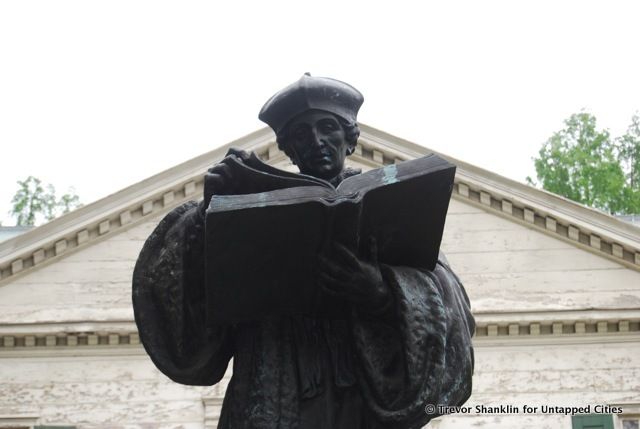
Nestled in the middle of Brooklyn lies one of New York’s most precious yet unrecognized treasures — Erasmus Hall. Arguably the oldest secondary school in the State of New York; the school has grown to become an iconic symbol in East Flatbush. The school’s roots date back to Dutch settlements in the late-1700s when it was built from a land grant and the generous donations of some of our founding fathers (i.e. Alexander Hamilton, Aaron Burr, Peter Lefferts and Robert Livingston). Erasmus Hall, initially consisting of one tiny wooden structure, was officially founded in 1787 and landmarked in 1966.
Due to the massive influx of immigrants and the passing of school attendance legislation, more and more students were crammed into the small Erasmus building up until the turn of the century. As a result, the City’s School Board presented plans for a new campus on the Erasmus site in 1904. The task was charged to C.B.J. Snyder, who was at the time the Superintendent of Buildings for the Board of Education. He has been credited with over 400 of New York City’s most architecturally-heralded schools. Snyder’s plans called for four new wings that would be phased in as classroom demand required them. The four sections adorned in the Collegiate Gothic Style popularized by Snyder became monuments to the East Flatbush neighborhood.

However, it is not the awe-inspiring civic exterior that is most notable about Erasmus (in this author’s opinion). It is the interior that provides the richest history of the building. It was said that Snyder liked to let the designs of his buildings seep into all of their forms, and the best way to achieve this was though artwork. While most artwork in schools at the time were commissioned paintings, hung as a symbol of the school, Erasmus was known to be different because it contained a type of art not typically found in schools: stained glass.
In fact, Erasmus has one of the most breathtaking collections of stained glass in the entire city; surpassing those of even some of the most prominent cathedrals. The works are placed throughout, finding their way into some of the most solitary sections of the school. One of the most breathtaking works is the collection of windows found in the school’s auditorium. One cannot help but be taken in while walking through the double-doors and into the massive expanse. Some of the school’s famous alumni such as Barbra Streisand, Neil Diamond and Mae West practiced for talent shows amidst the stained glass. As the hours of the day slowly pass, the colors of each sill expel a vibrancy that changes in an instant’s time to create a living work of art that plays off the subtlest changes in light.
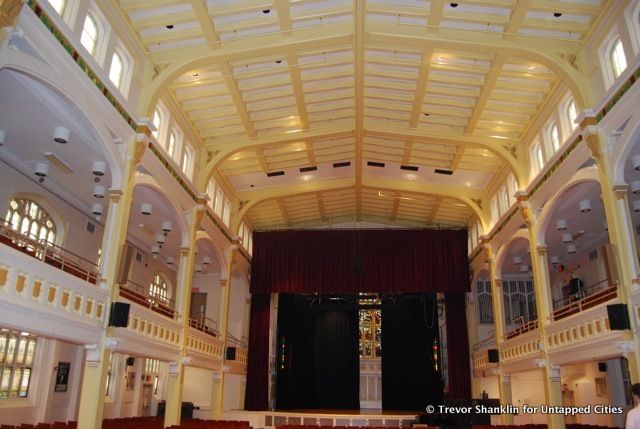
Windows to either side of the auditorium drift up towards the ceiling with three levels of colored shards that allow this experience to be felt from every conceivable angle. Patterned sequences of floral and geometric designs are set in panes of varying colors, textures and opalescence.
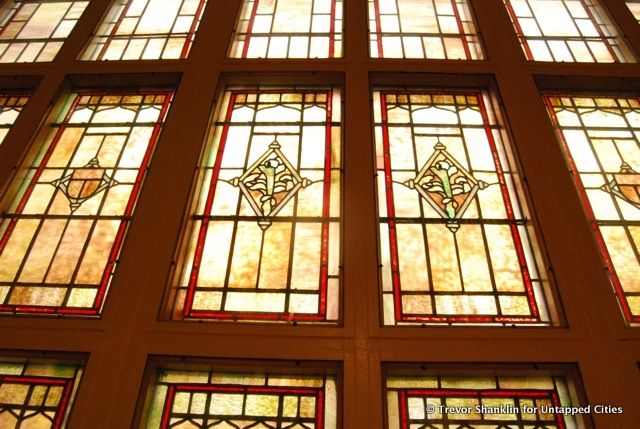
It is not until your look forward however, that you can take in the beauty of some of the finest details depicted in the Erasmus collection — The Life of Erasmus. Projected on the wall in the most brilliant of imagery lies the life of the school’s icon and namesake.

Once you come to your senses (and from an overwhelming subconscious desire to kneel and pay your respects), you make your way down the hallway to admire the next piece of stained glass that hangs proudly above the door leading to the school’s central courtyard. This banner of stained glass is aptly named Knowledge, depicting key events in the evolution of modern society in the United States.

Photo courtesy of NYC School Construction Authority
The school’s greatest work, however, is hidden from the public eye. The piece was commissioned in 1919 to honor the first principal of the school Walter B. Gunnison. It was created by Louis Comfort Tiffany, son of the famous jewelry company founder. The piece is only faintly visible from the street and perhaps more elusive from the inside as the work has to be viewed through plexiglass and a partition. Formations of the intricately stained glass have created a work that seems to lift itself out of its frame and towards the viewer. Tiffany was a master of his trade. He was able to create pearly opalescent veins of color that rushed through the glass like strokes of a brush (this is not to be confused with painted glass; Tiffany stained every individual piece).
With such great works of art, it is hard to imagine that Erasmus is also a fully functioning academic institution, in addition to an unofficial museum. This is understood only when the condition of some of the school’s neglected portions are viewed. The once pristine original Erasmus Hall is now a boarded up eyesore – the product of long standing budgetary constraints and a general disinvestment in the New York City school system.

Photo courtesy of NYC School Construction Authority
This same effect has also unfortunately begun to impinge on the stained glass collection of Erasmus. Colors have begun to fade, holes that are just as likely to come about from cracking and bending–typical pressures of humidity and aging in addition to the unavoidable haphazardness of youth–have emerged, and cracks in the panes themselves are all becoming visibly apparent.
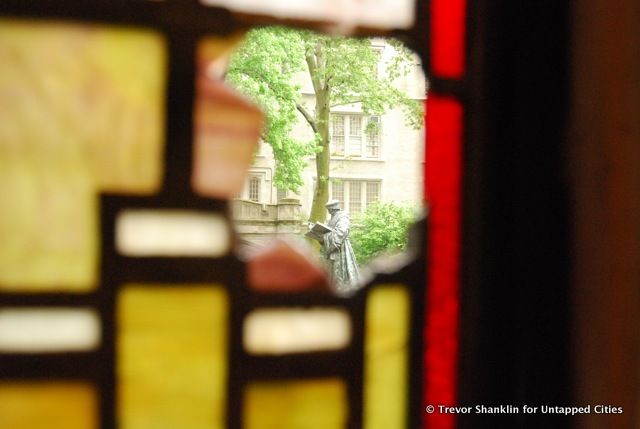
In order to stave off the further crumbling of this school’s most treasured possessions, Erasmus is now pitted against 39 other locations for a share of $3 million in grant funding from the Partners in Preservation effort to save New York City’s most treasured landmarks.
The collection of stained glass at Erasmus Hall, among many others of the school’s pieces, must be preserved. Scrolling down the list of preservation sites you see a sleuth of locations, each more deserving than the next for these much needed funds.
But, take a walk through the hallways of Erasmus, head to the courtyard and through the auditorium, aptly named the “Great Hall,” and consider how you felt when you saw these stained glass masterpieces for the first time. Now take a closer look at the opalescence of the glass as the light transitions throughout the day, each hour setting a distinct mood channeled throughout a seemingly endless array of colors. Finally, think for whom will preservation of these works of art benefit?
This restoration is not for the curators of museums, visitors or tourists. It is for the youth who walk past everyday on their way to class and interact consciously and unconsciously with this art. Although Erasmus is not located in a dense cultural corridor, it still contains one of the finest collections of artwork that I have ever seen in New York. This collection of stained glass has instilled a sense of pride for these students and their community, and this grant will afford them the opportunity to ensure that it is preserved for generations to come.
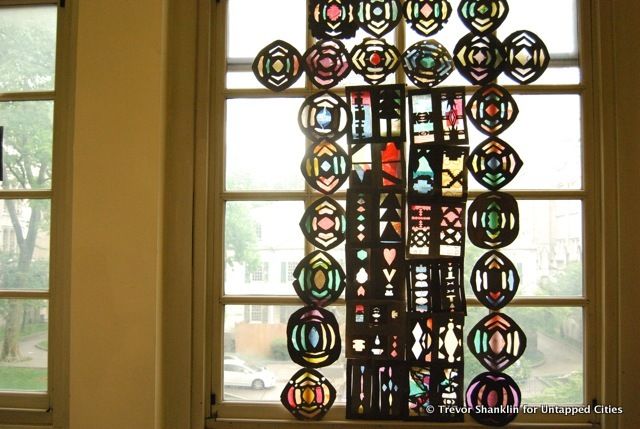
Click here to vote for Erasmus Hall, and find out more about the school on Facebook. Follow Untapped Cities on Twitter and Facebook.
Erasmus Hall High School [Map]
911 Flatbush Ave, Brooklyn, NY 11226
Untapped Cities is an official blog ambassador for Partners in Preservation , a community-based initiative by American Express and the National Trust for Historic Preservation to raise awareness of the importance of historic places. For complete coverage, follow our Partners in Preservation category.
Subscribe to our newsletter